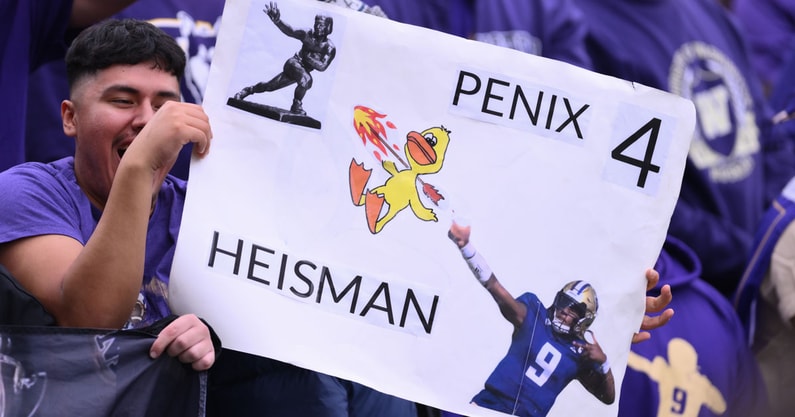Despite perceived 'absolute chaos,' parity driving college football's popularity surge

This past Saturday offered everything an avid college football fan could ask for: the first-ever meeting between Oregon and Washington as top-10 teams, followed by the annual USC–Notre Dame rivalry in prime time from South Bend.
Washington’s 36-33 victory over Oregon was a memorable thriller, lofting Huskies quarterback Michael Penix Jr. to the forefront of mid-season Heisman discussions. And Notre Dame’s 48-20 drubbing of defensively challenged USC proved that Caleb Williams is indeed human.
But the games were noteworthy on another level. The Pacific Northwest matchup on ABC trumped SC-Notre Dame on NBC in viewership: 7.04 million to 6.43 million.
This was far from an underwhelming matchup in South Bend. Both teams ranked in the top 20. And the viewership audience still represented the most-watched matchup between the two teams on NBC since 2009.
The SC-ND annual matchup typically attracts an audience that transcends garden variety college football fanatics. Oregon-Washington doesn’t normally have that broad of a reach. But these viewership numbers underscore increased parity that fans find alluring.
Ratings have been robust, storylines are fresh and compelling, and, overall, the sport is flourishing.
The parity, of course, is fueled by NIL and the transfer portal. Both quarterbacks who starred in Saturday’s most-watched game, Oregon’s Bo Nix and Penix, are transfers.
NIL, transfer portal fuel college football parity
There have already been 11 games this season to draw at least seven million viewers. That tops the 10 games that drew that large of an audience all of last season, according to Sports Media Watch.
College football isn’t exactly immersed in “absolute chaos,” as Sen. Lindsey Graham (R-SC) said during Tuesday’s NIL hearing. And the patchwork of state NIL laws hasn’t exactly caused “dangerous chaos,” as Sen. Richard Blumenthal (D-CT) characterized the industry.
The sport’s popularity is surging. And athletes are monetizing their brands.
“Is it really chaos when college football has viewership that is better than history has shown in the past?” Jim Cavale, who recently launched Athletes.Org, told On3. “It’s got parity that doesn’t have us going, like, ‘The only teams with a chance to win a championship this year are Alabama and Georgia.’ And athletes who might have been sitting on the bench are actually getting a chance to play and showcase their talents. So those are all great things.”
On3 is a media partner with Athletes.Org.
Cavale said players who once needed to go to schools like Alabama and Georgia and sit on the bench a few years before starting are now going to other schools and starting right away. NIL has played a central role in that trend, thus dispersing more talent throughout the country.
In other high-interest games Saturday, Tennessee–Texas A&M attracted 4.38 million on CBS. Stanford’s 29-point comeback over Colorado drew 3.29 million despite a late Friday night kickoff on ESPN. Even the Iowa–Wisconsin game – an unsexy matchup devoid of much offense – saw 2.34 million viewers on FOX Sports.
Top 10
- 1Breaking
Ryan Day picks OC
Brian Hartline promoted at Ohio State
- 2
Brian Kelly responds
Greg Brooks Jr. allegation amid lawsuit
- 3
Jalen Milroe
'You don't ask a zebra to be a dog'
- 4
Fake injury punishment
NCAA takes aim
- 5
Tom Osborne
'NCAA has become somewhat irrelevant'
Get the On3 Top 10 to your inbox every morning
By clicking "Subscribe to Newsletter", I agree to On3's Privacy Notice, Terms, and use of my personal information described therein.
Despite “absolute chaos,” people are watching, and the sport’s popularity is surging.
Will Big 12 decouple basketball rights?
As expected, forward-thinking Big 12 Commissioner Brett Yormark said he’s open to the possibility of decoupling basketball from football to create separate rights properties down the road.
Last October, the league signed a six-year extension with FOX and ESPN for $2.2 billion, a deal that looks better by the day as industry conditions have cooled over the past year. Offering basketball as a standalone property may not work for some leagues. But it’s an interesting proposition for the Big 12, which has long boasted the nation’s strongest regular-season men’s basketball league.
“In our recent TV negotiations, which obviously were concluded about a year ago, we gave ourselves some optionality when you think about our back-end rights,” Yormark said at Big 12 basketball media days. “Not only to renew in the traditional format but also to potentially break apart basketball from football.
“I think my job as commissioner, our job as a conference office, is to explore all options and to further monetize what we do and to create value for our member institutions.”
Yormark has made clear to On3 and others that he wants to double down on basketball and views it as an undervalued asset. Its recent rounds of expansion – especially adding Kelvin Sampson’s Houston program and perennial contender Arizona – have only bolstered its status as the nation’s premier hoops league (apologies to Danny Hurley and the rest of the Big East).
A commitment to continue to build upon its impressive basketball foundation is the reason behind the Big 12’s continued flirtation with Gonzaga, a national brand in basketball that is especially popular with Yormark’s target audience: Gen Z.
Bob Thompson, the retired Fox Sports Networks president, tweeted that many conferences over the years have had separate contracts for football and basketball. The move to blanket contracts, he said, started occurring some 20 years ago.
“If a situation presents itself where we can create more value by decoupling football from basketball, we’ll pursue it,” Yormark said. “But that doesn’t mean we’re going to do it. At least we have the optionality to pursue it if we feel it’s appropriate.”